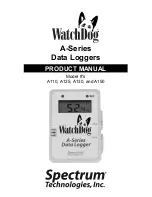
Pro II: Extension and Interface Modules
Pro II-SENT-4-Out Rev. E
ADwin
206
ADwin-Pro II
Hardware, manual Dec. 2018
Fig. 173 – Pro II-SENT-4-Out Rev. E: Pin assignment and front panel
Fig. 174 – Pro II-SENT-4-Out Rev. E: Block diagram
Working with SENT
Terminology
The SENT protocol works as point-to-point connection, which transfers signal
values from a sensor to a controller. A SENT message consists of 9 or 10
pulses:
– 1 calibration pulse for synchonization
– 1 nibble pulse (1 nibble = 4 bit): Status and communication, contains
amongst others 1…2 Bits of the serial message.
– 3 nibble pulses: first 12-bit value of the sensor
– 3 nibble pulses: second 12-bit value of the sensor
– 1 nibble pulse: CRC checksum of the data pulses
– optionally 1 pause pulse
The length of pulses and SENT messages is measured in clock ticks. The
clock tick can have a length of 3µs…90µs.
A serial message consists of an ID, a data value and a CRC checksum. The
sending format (standard, enhanced 1, enhanced 2) determines the number of
bits for ID and data value. Serial messages are sent distributed to several
SENT messages, only 1…2 bits per message.
Several (up to 32) serial messages form a message set. The message set is
transferred cyclically.
Operation modes
The module distinguishes two operation modes for sending:
– Continuous mode: The module continuously sends the currently defined
SENT messsage.
GND DIGIO
RESERVED
GND SENT
DIGOUT 27
DIGOUT 26
DIGOUT 25
DIGOUT 24
SENT 4 OUT
SENT 3 OUT
SENT 2 OUT
SENT 1 OUT
RESERVED
GND SENT
DIGIN 19
DIGIN 18
DIGIN 17
DIGIN 16
1
2
3
4
5
6
7
8
9
10
11
12
13
14
15
16
17
18
19
20
21
22
23
24
25
26
27
28
29
30
31
32
33
34
35
36
37
RESERVED
RESERVED
SENT-4-O
ADwin-Pro
II
-Bus
Daten-
Register Daten
SENT 1-4 OUT
D08:15
...
...
EMI
Isolator
...
...
DIGIN 16-19
10k
D16:23
Bus-
Trans-
ceiver
...
..
.
DIGOUT 24-27
10k
D24:31
Bus-
Trans-
ceiver
...
..
.
















































